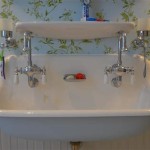How to Install a Bathroom Sink and Faucet
Installing a bathroom sink and faucet is a project that homeowners can tackle with the right tools and knowledge. This project requires some basic plumbing skills, but with careful planning and execution, it can be completed successfully. This article will guide you through the steps involved in installing a bathroom sink and faucet, offering tips and strategies to ensure a smooth and efficient process.
Step 1: Preparation and Gathering Materials
Before beginning the installation, it's crucial to gather all necessary materials and tools. This includes the bathroom sink, the faucet, the drain assembly, a drain pipe, a plumber’s putty, plumber’s tape, a wrench, adjustable pliers, a level, and a utility knife. It's also recommended to have a helper on-hand to assist with holding and positioning the sink.
Once the materials are gathered, it's time to prepare the area for installation. This involves turning off the water supply to the bathroom sink by locating the shut-off valve and turning it clockwise. Next, drain the existing sink by opening the drain and allowing the water to flow out. Finally, remove the old sink and faucet by disconnecting the supply lines and the drain pipe. This step usually involves loosening nuts and disconnecting pipes.
Step 2: Installing the Sink
The next step is to install the sink. This process involves installing the sink drain assembly and securing the sink to the countertop or vanity. Start by placing the sink drain assembly onto the sink drain hole, ensuring a snug fit. Next, apply a thin layer of plumber’s putty around the base of the sink drain assembly, ensuring a watertight seal. The plumber’s putty acts as a sealant to prevent leaks.
Then, position the sink onto the countertop or vanity, ensuring it is level. Use a level to verify that the sink is properly aligned. The sink should be securely attached to the countertop or vanity with appropriate fasteners.
Step 3: Installing the Faucet
The next step is to install the faucet. Before attaching the faucet, apply plumber’s tape to the threads of the supply lines. This tape creates a seal to prevent leaks. Screw the supply lines into the faucet, ensuring they are hand-tight.
Now, it’s time to attach the faucet to the sink. Most bathroom faucets have a mounting plate that secures the faucet to the sink. Install the mounting plate according to the faucet’s instructions, typically using screws provided. The faucet should now be connected to the supply lines. Be sure to check for any leaks before proceeding.
Step 4: Connecting the Drain Pipe
The final step in the installation process is connecting the drain pipe to the sink drain assembly. This process usually involves attaching a P-trap to the sink drain assembly and then connecting the drain pipe to the P-trap. Use a wrench to tighten all connections, ensuring a secure and watertight seal.
Once the drain pipe is connected, turn the water supply back on and check for leaks around the faucet, supply lines, drain assembly, and drain pipe connections. If there are any leaks, it’s best to address them immediately to avoid future issues. To address any leaks, retighten any loose connections, reapply plumber’s putty, or replace any damaged components.

How To Install A Bathroom Faucet The Home Depot

How To Install A Bathroom Faucet Diy Guide

How To Install A Bathroom Faucet The Home Depot

How To Install A Bathroom Faucet The Home Depot

Diy How To Replace And Install A Bathroom Sink Faucet

How To Replace A Bathroom Faucet Removal And Installation

Step By Tutorial How To Install A New Bathroom Sink Faucet Maggie Mcgaugh
Diy Installing A 3 Hole Sink Faucet In 6 Easy Steps

How To Install A Bathroom Vanity Hook Up The Faucet And Backsplash Diy Step By

How To Install A Bathroom Faucet In 6 Steps Do It Best
Related Posts







